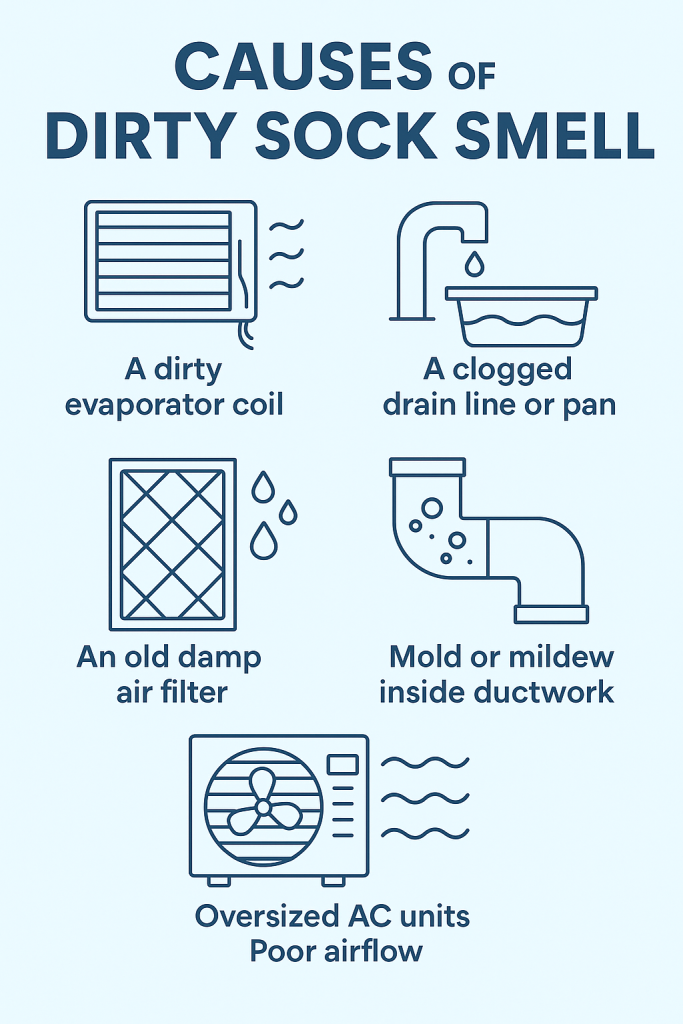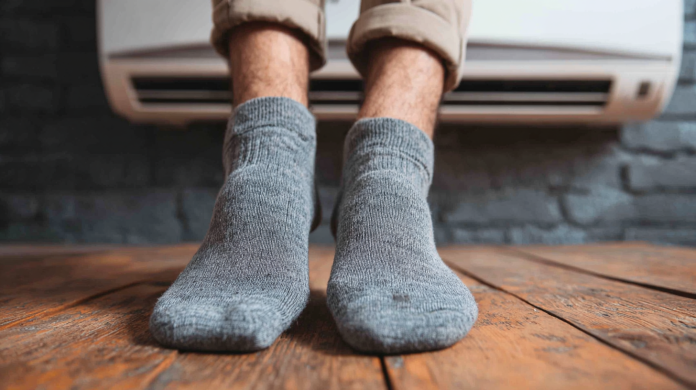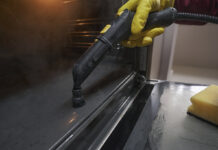Nothing kills a cool breeze faster than an air conditioner that blasts out a smell like a pile of old, sweaty socks. I see this every spring and summer — homeowners think their whole system is ruined when really, they just need to tackle some mold and grime. The good news? Most of the time, it’s fixable if you know what to check and how to clean it up.
Causes of the Dirty Sock Smell
That musty, sour odor is so common there’s actually a name for it in the HVAC world: Dirty Sock Syndrome. It’s exactly what it sounds like — bacteria and mold build up inside your air conditioner, especially on the evaporator coil and in the drain pan where moisture collects. Your AC is supposed to pull heat and humidity out of your air, but when dust and dirt mix with that moisture, they make the perfect breeding ground for mold and mildew. When your system kicks on, that stinky air gets pushed through your ducts and right into your living room. The usual culprits behind this are a dirty evaporator coil caked with dust and grime, a clogged drain line or pan that lets water sit and get stagnant, an old damp air filter trapping moisture, mold or mildew inside ductwork if you have leaks, or an oversized AC unit with poor airflow that short-cycles and never runs long enough to dry out properly.

How to Get Rid of the Dirty Sock Smell: Step-by-Step
Covering up the smell with candles or sprays won’t solve the problem — you need to get rid of what’s feeding the bacteria. Here’s what I tell homeowners to do if they want that funky odor gone for good:
Step 1: Replace your air filter.
Check your filter first — it’s the easiest fix. If it’s clogged or looks damp and grimy, swap it out immediately. Use the right size and don’t go overboard on the MERV rating; too restrictive can hurt airflow.
Step 2: Clean the drain line and pan.
Find the condensate drain line — it’s usually a PVC pipe coming out of your indoor unit. Use a wet/dry shop vac to suck out blockages. Then pour a cup of white vinegar through the line to help kill mold and algae. If you see standing water in the drain pan under the coil, you may have a clog that needs to be cleared.
Step 3: Inspect and clean the evaporator coil.
This is where most of the smell comes from. The coil is usually behind a small panel. If you see a layer of gunk or slimy buildup, that’s your problem. You can use a no-rinse coil cleaner if it’s minor, but for heavy buildup, get a pro — the coil is fragile and easy to damage if you’re not careful.
Step 4: Look for mold in the ductwork.
If the smell is stronger in certain rooms or vents, mold might be growing inside the ducts. A reputable duct cleaning company can inspect it. Don’t get scammed into unnecessary whole-house duct cleaning if it’s not needed — make sure they show you the problem first.
Step 5: Consider a UV light or coil sanitizer.
If you live in a humid climate and this smell keeps coming back every year, adding a UV light near your evaporator coil can help kill mold and bacteria before they build up again. It’s not for everyone, but it can help some households keep things fresh.
How to Keep That Funky Smell from Coming Back
Once you’ve knocked out the source of the smell, the best thing you can do is keep up with simple AC maintenance. This makes a huge difference — and saves you from breathing in musty air all summer.
- Change your air filter every month during peak cooling season.
- Pour a little vinegar down the drain line every few months to keep mold and algae at bay.
- Schedule a yearly AC tune-up. A good tech will clean your coil, check your drain, and spot problems before they get stinky.
- Keep your home’s humidity in check. Use ceiling fans and a dehumidifier if needed — lower humidity means less mold.
- Don’t push your AC too hard. Setting your thermostat too low can lead to extra condensation the system can’t handle.
When to Call a ProThe Bottom Line
If you’ve replaced the filter, cleaned the drain, and still get hit with that sour sock smell every time your AC runs, it’s time to call a trusted HVAC tech. Persistent odor could mean mold or bacteria deep in the coil or ducts, and that’s not something you want blowing through your house — especially if you or your family have allergies or asthma.
Sometimes, the best move is a thorough professional coil cleaning, a duct inspection, or even upgrading to a newer, better-sized system if the problem keeps coming back every year.
The Bottom Line
That dirty sock smell is gross, but it’s also your system’s way of telling you something’s off. Things like regular filter changes, drain line checks, and keeping your coil clean can save you a lot of headaches and help your AC blow fresh, healthy air all season long.


















